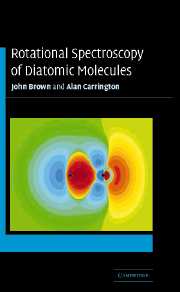Book contents
- Frontmatter
- Contents
- Preface
- Summary of notation
- Figure acknowledgements
- 1 General introduction
- 2 The separation of nuclear and electronic motion
- 3 The electronic Hamiltonian
- 4 Interactions arising from nuclear magnetic and electric moments
- 5 Angular momentum theory and spherical tensor algebra
- 6 Electronic and vibrational states
- 7 Derivation of the effective Hamiltonian
- 8 Molecular beam magnetic and electric resonance
- 9 Microwave and far-infrared magnetic resonance
- 10 Pure rotational spectroscopy
- 11 Double resonance spectroscopy
- General appendices
- Author index
- Subject index
- References
5 - Angular momentum theory and spherical tensor algebra
Published online by Cambridge University Press: 17 December 2010
- Frontmatter
- Contents
- Preface
- Summary of notation
- Figure acknowledgements
- 1 General introduction
- 2 The separation of nuclear and electronic motion
- 3 The electronic Hamiltonian
- 4 Interactions arising from nuclear magnetic and electric moments
- 5 Angular momentum theory and spherical tensor algebra
- 6 Electronic and vibrational states
- 7 Derivation of the effective Hamiltonian
- 8 Molecular beam magnetic and electric resonance
- 9 Microwave and far-infrared magnetic resonance
- 10 Pure rotational spectroscopy
- 11 Double resonance spectroscopy
- General appendices
- Author index
- Subject index
- References
Summary
Introduction
Much of the beauty of high-resolution molecular spectroscopy arises from the patterns formed by the fine and hyperfine structure associated with a given transition. All of this structure involves angular momentum in some sense or other and its interpretation depends heavily on the proper description of such motion. Angular momentum theory is very powerful and general. It applies equally to rotations in spin or vibrational coordinate space as to rotations in ordinary three-dimensional space.
All the laws of physics are easier to accept (and even to understand) when the underlying symmetry of the problem is appreciated. For example, classical Euclidean space is isotropic and a physical system is invariant to any rotation in this space. By this we mean that all the measurable properties of the system are unaffected by the rotation. An investigation of the behaviour of a quantum state under such rotations allows the properties of the state to be defined. These properties are most succinctly expressed as quantum numbers. Although quantum numbers are frequently used to label the eigenstates or eigenvalues of a molecule, they really carry information about the symmetry properties of the associated eigenfunctions.
In this chapter we give only a brief description of angular momentum theory, sufficient to introduce the various techniques required for the description of molecular energy levels and the transitions between them.
- Type
- Chapter
- Information
- Rotational Spectroscopy of Diatomic Molecules , pp. 139 - 176Publisher: Cambridge University PressPrint publication year: 2003

